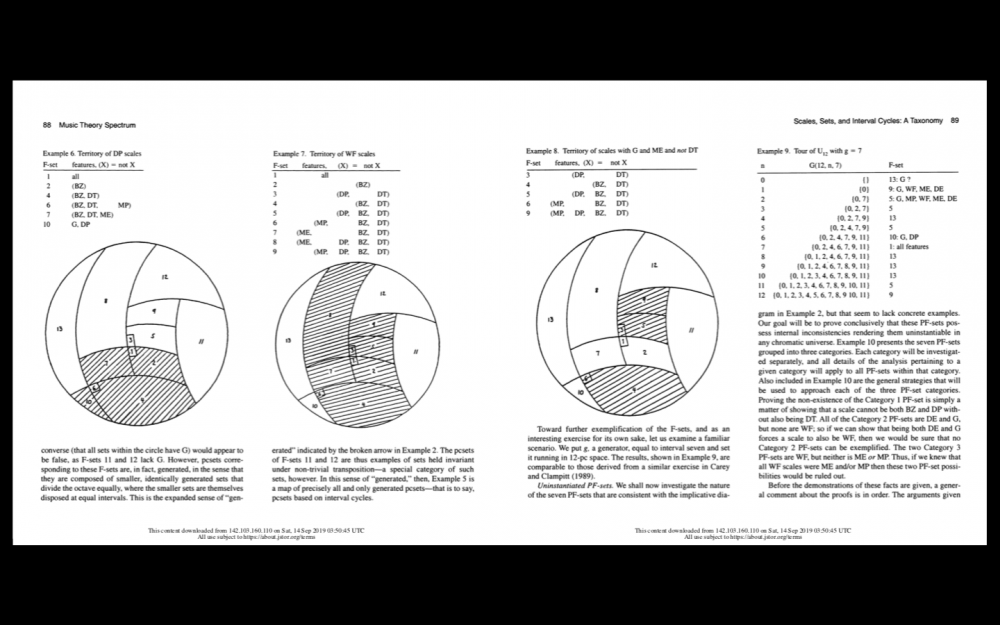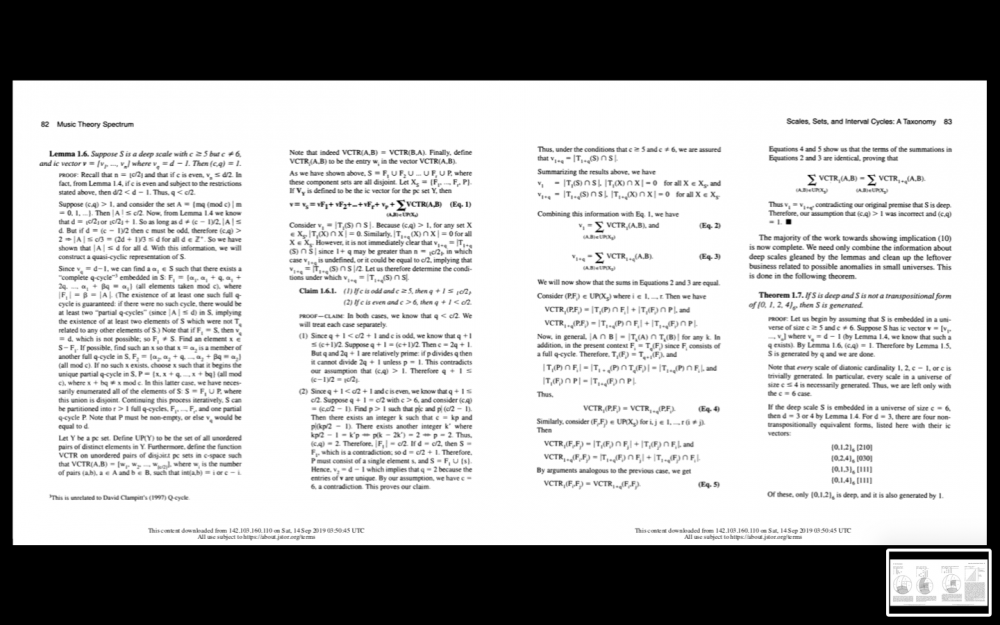Leaderboard
Popular Content
Showing content with the highest reputation on 11/02/2019 in all areas
-
Hi guys, I just found this forum and signed up straight ahead. And so this is my first post here. Something about my composition. Like the title says, it is my first composition I did with Studio One. Also this is one out of 3 total composition, I used to apply to some music universities, to show, how far my skills are. But I also wanted you guys to evaluate it and maybe give me some tipps. Hope you like it :)2 points
-
This is sort of an extension of the conversation @Ken320 and I were having on the chat. I was basically saying that, in my experiences reading/discussing Allen Forte: 1. Forte wanting to have it both ways (saying that it doesn't matter what the composer did, since we can never fully know anyway, and also claiming that Schoenberg/Webern/etc. strongly cared about PC sets in his music), essentially begging the question 2. There is no evidence of Schoenberg using PC sets in his music, despite us having ample evidence that he thought very deeply about how to formulate tone rows 3. the interlocutor theorists being unable to hear any of the relationships that Forte describes with PC sets 4. claiming Forte is attempting to take over the composer's authority with Forte's own as a theorist. I can definitely see where they come from, especially with No. 3. Quick rundown on PC sets: 1. convert pitch classes to numbers [C G A] -> [0 7 9] 2. transpose to 0 [0 7 9] 3. find the shortest distance between any consecutive ascending form of the set [7 9 0] 4. transpose to 0 (025). The set class is (025). Any transposition of (025), forwards or backwards is part of set (025). Forte would use these set classes in millions of ways; inverting them, finding every instance of it and its 12-tone aggregate complement in any atonal piece (segmentation), finding interval class vectors, using those vectors to construct genera of potential subsets and supersets, the list goes on. Many Forte followers have introduced many additional concepts to his theories like set multiplication, maximally related sets, etc. These arguments don't stop with atonal analysis; Schenkerian analysis for tonal music gets a lot of heat for being so reductionist that the music isn't really even being analyzed anymore. Some people even think the way we analyze chords with Roman numerals is reductionist. Even though I think analysis is inherently reductionist, I'm curious as to what anyone thinks about this kind of stuff and would be willing to go through any strange concepts (though I'm not an expert in any way). I feel like as composers we have a different take on this kind of thing.1 point
-
1 point
-
Hello all :), It's my little piano composition. I' m self- taught musician so please, be understanding. :)1 point
-
@Tónskáld @Monarcheon Agree. In fact, from my point of view it's a good point that what comes after the shared initial part be related to it. Transformation/development is a blurred frontier. Also, the material can be inspired in the style, for example, of the initial part, and in this case, smooth and natural transition should be in mind. Perhaps a graphic representation is the branches of a tree where the trunk is the shared material and the main branches are the parts, and the little branches internal development. In some way everything is related to the trunk. (Off topic: tree branches follow the fibonacci series pattern, often used in contermporary and even in previous periods of music. But that's another story.)1 point
-
Maybe that should have been more clear. I meant the literal exact repetition (orchestration, rhythm, etc.) should always be at the front of the movements, but thematic development (i.e. sentence form) are okay for the movement's development. However, this is not the only way to develop a theme, so you should still be just fine. 🙂 This is a weird competition, so we'll be a little lax as long as we can tell development was thought about.1 point
-
Yes, many people suppose that. But for me, it tells more like a story, how this person became an anatagonist, or like the emotional inside of this person.1 point
-
Thanks @Jean Szulc for reviewing 🙂 Well as to follow your critic I could say that maybe this piece lacks more variations in intensity, more contrasts between a piano and a forte section for instance. Moreover, as being unused to this B Major tonality, maybe I stick too much to the tonic note. I rarely start a composition with an intention, at most may I have a starting theme in mind, but then I let the flow come out... Here the structure is ABACA. Thanks again 🙂1 point
-
** I suggest we stick to seven albums and that would be enough. *** LMAO - The understatement is regal.1 point
-
1 point
-
By reductive do you mean simplistic? Lacking pertinent information? Looking at the illustrations, no, they don't immediately invoke some aspect of music. But I'm guessing there are relationships, proximity, intersections and such. Why aren't basic analyses like ABA, ABBA, which could be used a conversation starters now considered inadequate? Is there an aspect of deconstruction in this approach, sort of like Derrida, who I think would say that you shouldn't read anything into a narrative. Everything must be contained on the page,1 point
-
I mean, I get it. The music of Schoenberg, Webern, Berg, Boulez, Babbit, Coltrane, etc. can't be easily formed into what we'd used to analyze music up to that point. So we came up with a another system; Bach certainly didn't think about chord symbols/roman numerals when he wrote his music. But when you look at the screenshots I've posted below (what I'm studying right now), does anyone really think they're describing the music they're hearing anymore? Like I said before, analysis is necessarily reductive, but my Schenkerian teachers always told me that relationships that are reduced need to be heard for them to be legitimate graphing points. We're studying contour relationships in atonal music now and while not all the theories are obviously heard, it's more audible than constant segmentation of PC sets.1 point
-
Thanks for that explanation. Such analysis of alternates reminds me of two men discussing whether or not man is selfish by nature or generous by nature, and why each one is preferable to the other. And after revealing layer after layer and each side being forced to distill its own logic we come up with the idea that it is actually selfish to be generous and generous to be selfish, and that both of these coexist as necessarily so. And maybe the joke is that after all the machinations, it really doesn't matter. Aside from the analysis, I understand that the musical goal is to avoid the ego and substituting various systems in its place. And that the result will be, if nothing else, fresh and without precedent. And I am reminded (again) of the film maker David Lynch, an intuitive artist in process, who is often imitated, but never duplicated. Because his films are so puzzling, people are always asking him, "Why did you do this or that is your film?" And it could be anything. A frenetic scene, or something frightening and filled with anguish and mystery. And he just says, I thought it was beautiful.1 point
-
Some short pieces. Six Piano Pieces.pdf 01 Aeolian (Winds).mp3 02 The Hummingbird's Phrygian Flight.mp3 03 Quick Diminished Changes.mp3 04 Can We Be Friends.mp3 05 Longing Worlds.mp3 06 Gemini II.mp31 point
-
I'm hesitant to post too many of them, but this is the 5th guitar prelude just to show what comes directly after Aurora. @Ken320, this is more or less where it goes to after Aurora. It's supposed to be quite the major departure. The next two after that are also atonal, until the final.1 point






